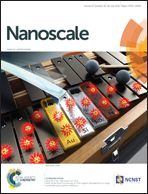Size dependent electrochemical detection of trace heavy metal ions based on nano-patterned carbon sphere electrodes†
Abstract
The challenge in efficient electrochemical detection of trace heavy metal ions (HMI) for early warning is to construct an electrode with a nano-patterned architecture. In this study, a range of carbon electrodes with ordered structures were fabricated using colloidal hollow carbon nanospheres (HCSs) as sensing materials for trace HMI (represented by Pb(II)) detection by square wave anodic stripping voltammetry. The regular geometrical characteristics of the carbon electrode allow it to act as a model system for the estimation of electron transfer pathways by calculating contact points between HCSs and a glassy carbon electrode. A clear correlation between the contact points and the electron transfer resistance has been established, which fits well with the quadratic function model and is dependent on the size of HCSs. To our knowledge, this is the first clear function that expresses the structure–sensing activity relationship of carbon-based electrodes. The prepared carbon electrode is capable of sensing Pb(II) with a sensitivity of 0.160 μA nM−1, which is much higher than those of other electrodes reported in the literature. Its detection limit of 0.6 nM is far below the guideline value (72 nM) given by the US Environmental Protection Agency. In addition, the carbon electrode could be a robust alternative to various heavy metal sensors.


 Please wait while we load your content...
Please wait while we load your content...